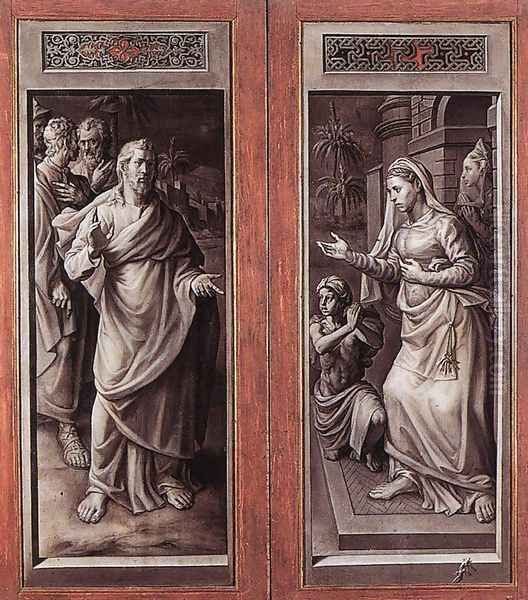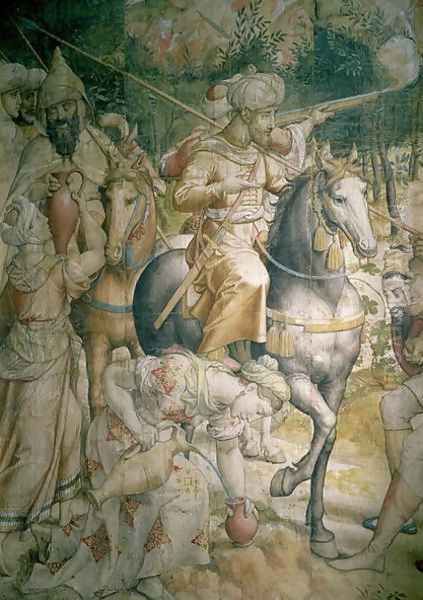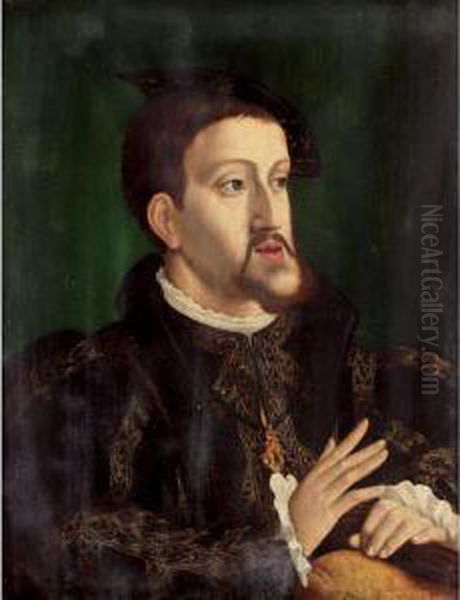Jan Cornelisz Vermeyen stands as a significant, if sometimes overlooked, figure in the rich tapestry of 16th-century Northern European art. Active primarily in the Habsburg Netherlands, he was a versatile artist renowned for his penetrating portraits, intricate tapestry designs, and his unique role as an eyewitness chronicler of military campaigns. His career was inextricably linked with the most powerful ruler of his age, Holy Roman Emperor Charles V, placing Vermeyen at the crossroads of art, politics, and history. This exploration delves into his life, artistic development, major works, and his enduring, though often subtle, influence on the art of his time and beyond.
Early Life and Artistic Formation
Born around the year 1500 in Beverwijk, near Haarlem in the Northern Netherlands, Jan Cornelisz Vermeyen's early life and artistic training are not extensively documented, a commonality for many artists of this period. It is widely believed that his initial artistic instruction came from his father, Cornelis Vermeyen, who was himself a painter, though little is known of the elder Vermeyen's own work. This familial apprenticeship would have provided a foundational understanding of painting techniques and workshop practices prevalent in the region.
The artistic environment of the Netherlands in the early 16th century was vibrant and undergoing significant transformation. The legacy of Early Netherlandish masters like Jan van Eyck and Rogier van der Weyden, with their meticulous detail and oil painting innovations, still resonated. However, new influences, particularly from the Italian Renaissance, were beginning to permeate the North, brought back by artists who had traveled south or through the dissemination of prints.

A pivotal figure in Vermeyen's development was likely Jan Gossaert, also known as Mabuse (c. 1478–1532). The provided information suggests Vermeyen was a student of Gossaert. Gossaert was one of the first Netherlandish artists to travel to Italy and absorb classical ideals, which he then integrated into his distinctly Northern style. If Vermeyen did indeed study under Gossaert, he would have been exposed to this burgeoning Romanism, a style that sought to combine Northern realism with Italianate forms, mythological subjects, and an understanding of classical anatomy and architecture. This tutelage would have been crucial in shaping Vermeyen's sophisticated approach to form and composition. He also maintained close ties with Jan van Scorel (1495-1562), another key figure in introducing Italian Renaissance ideas to the Netherlands, and their interactions would have further enriched his artistic perspective.
Ascent in the Habsburg Courts
Vermeyen's talent did not go unnoticed, and by 1525, he had entered the service of Margaret of Austria, the Regent of the Habsburg Netherlands and aunt of Charles V. Margaret was a significant patron of the arts, and her court at Mechelen was a cultural hub. Serving such a discerning patron would have provided Vermeyen with invaluable experience, exposure to other leading artists, and opportunities to refine his skills, particularly in portraiture, which was highly valued in courtly circles. Artists like Bernard van Orley (c. 1487/1491 – 1541), another prominent painter and tapestry designer at Margaret's court, would have been contemporaries whose work and status Vermeyen would have been well aware of.
Following Margaret's death in 1530, Vermeyen transitioned into the service of Mary of Hungary, Charles V's sister, who succeeded Margaret as Regent. Mary, like her aunt, was a formidable political figure and an avid art collector and patron. Her continued employment of Vermeyen underscores his growing reputation and the esteem in which his work was held. It was during this period that his connection with the imperial family deepened.
His skill, particularly in capturing a likeness and conveying the status of his sitters, evidently impressed the highest echelons of the Habsburg dynasty. This culminated in 1534 when Emperor Charles V himself appointed Jan Cornelisz Vermeyen as his principal court painter. This was a prestigious position, placing Vermeyen in the direct service of one of the most powerful men in the world, whose empire stretched across Europe and the Americas.
The Tunis Campaign: A Defining Commission
A defining moment in Vermeyen's career, and one that cemented his historical importance, was his participation in Charles V's military expedition to Tunis in 1535. The campaign was a major strategic undertaking by the Emperor, aimed at dislodging the Ottoman-backed corsair Hayreddin Barbarossa from this key North African port and curbing Barbary pirate raids in the Mediterranean. Charles V, ever conscious of his image and legacy, understood the power of art to commemorate and propagandize his achievements.

Vermeyen was specifically tasked with accompanying the expedition as an official artist, a role akin to a modern-day war correspondent or embedded artist. His mission was to create a visual record of the campaign – the landscapes, the sieges, the battles, and the eventual Christian victory. This was an extraordinary assignment, requiring not only artistic skill but also resilience and courage to endure the rigors of a military campaign in a foreign land. He meticulously sketched scenes, fortifications, and events as they unfolded, gathering the raw material for what would become his most famous works. This direct, observational approach was crucial for the authenticity and detail that would later characterize his depictions of the war.
Artistic Style and Techniques
Jan Cornelisz Vermeyen's artistic style is characterized by a blend of Northern Netherlandish realism and an emerging understanding of Italian Renaissance principles, likely filtered through artists like Gossaert and Scorel. He possessed a remarkable facility for detailed observation and a delicate, refined handling of paint and other materials.
In his portraiture, Vermeyen excelled at capturing not only the physical likeness of his sitters but also their psychological presence and social standing. His portraits are often sober and direct, with a keen attention to the textures of fabrics, fur, and jewelry, all rendered with meticulous precision. He employed a subtle use of chiaroscuro (the interplay of light and shadow) to model faces and create a sense of three-dimensionality, as seen in works like the panel of Saint Donatian, where the saint's features and the texture of his skin are rendered with convincing plasticity.
His work shows an awareness of, and perhaps influence from, the great German master Albrecht Dürer (1471–1528), particularly in the incisive quality of his drawing and the psychological depth of his characterizations. Dürer’s own travels and his widely circulated prints had a profound impact across Northern Europe, and Vermeyen would undoubtedly have been familiar with his work.
When it came to designing for tapestries, Vermeyen demonstrated a strong grasp of narrative composition and the ability to manage complex, multi-figure scenes. Tapestry design required a different skillset than panel painting; the artist had to think in terms of broad effects, clear outlines, and compositions that would translate effectively into woven form. His designs for the Tunis tapestries showcase his ability to organize vast amounts of information – troops, ships, landscapes, architectural elements – into coherent and dramatic visual narratives.
Key Works Explored
While many of Vermeyen's works may have been lost over time, several key pieces and series define his artistic contribution.
The Conquest of Tunis Tapestries

Undoubtedly Vermeyen's most celebrated achievement is the series of twelve monumental tapestries depicting The Conquest of Tunis. Based on the sketches and observations he made during the 1535 campaign, Vermeyen designed the cartoons (full-scale preparatory drawings) for these magnificent hangings. The tapestries were woven in the Brussels workshop of Willem de Pannemaker, one of the leading weavers of the era, between 1546 and 1554. Pieter Coecke van Aelst (1502-1550), another prominent artist and tapestry designer, also collaborated on aspects of this massive project, highlighting the collaborative nature of large-scale commissions.
These tapestries were far more than mere decorations; they were powerful statements of imperial triumph and Christian might. They meticulously chronicled the various stages of the campaign, from the fleet's departure to the siege of La Goleta and the final capture of Tunis. Vermeyen's firsthand experience lent an unparalleled authenticity to the scenes. He depicted not only the grand sweep of military maneuvers but also ethnographic details, North African landscapes, and even ancient ruins, such as those of Carthage, which he incorporated into the backgrounds.
Art historians have often referred to these tapestries as a form of "official war photography" for the 16th century, providing a vivid, almost cinematic, account of the events. Their scale, detail, and narrative power made them one of the most important artistic undertakings of the Northern Renaissance. Tragically, many of the original tapestries were destroyed during the iconoclastic fury (Beeldenstorm) of 1566 or in subsequent conflicts. However, ten of the original set are preserved in the Kunsthistorisches Museum in Vienna, and a later 17th-century set woven for the Spanish crown resides in the Palacio Real in Madrid, testifying to their enduring importance.
The Micault Triptych
Another significant work attributed to Vermeyen is The Micault Triptych (also known as the Triptych of the Micault Family or Jean Micault and his Family), now in the Royal Museums of Fine Arts of Belgium, Brussels. This altarpiece, likely dating from the 1530s, depicts Jean Micault, a receiver-general for Charles V, his wife Livine Cats van Welle, and their children adoring the Holy Trinity and the Virgin and Child.
The triptych is a fine example of Renaissance religious painting in the Netherlands. The central panel shows the Adoration of the Magi, while the wings feature the donors. Vermeyen's skill in portraiture is evident in the individualized features of the Micault family members. The painting also showcases his interest in classical architecture and landscape. Notably, in the background of one of the panels, Vermeyen includes a depiction of the Roman aqueduct of Segovia, a detail that reflects his travels and his interest in ancient monuments, similar to his inclusion of Carthaginian ruins in the Tunis tapestries. This integration of observed reality and classical elements is a hallmark of his mature style. The meticulous rendering of textures and the rich, luminous colors are characteristic of the Netherlandish tradition, while the balanced composition and idealized figures show an awareness of Italianate trends.
Portraiture
Throughout his career, Vermeyen was a sought-after portraitist. He painted numerous members of the Habsburg court and other dignitaries. One of his notable portraits is that of Charles V (c. 1530). While Titian (Tiziano Vecellio, c. 1488/1490–1576) would later become Charles V's most famous portraitist, creating iconic images of imperial power, Vermeyen's earlier portrayals provided a more intimate, Northern perspective. His portraits are characterized by their psychological acuity and unsparing realism, capturing the sitter's personality as well as their physical appearance.
He also depicted other key figures such as Erard de la Marck, Prince-Bishop of Liège, and various courtiers and their families. These works demonstrate his consistent ability to convey status and individuality with refined technique. The precision in his work sometimes invites comparison with contemporaries like Hans Holbein the Younger (c. 1497–1543), another master portraitist active in Northern Europe and England, known for his sharp characterizations.
Vermeyen as a Draftsman and Printmaker
Beyond his paintings and tapestry designs, Jan Cornelisz Vermeyen was also an accomplished draftsman and etcher. His drawings, often preparatory studies for larger works, reveal his keen eye for detail and his fluid, confident line. Etching was a relatively new medium in the early 16th century, and Vermeyen was among the Netherlandish artists who explored its potential.
His prints, though not numerous, demonstrate his skill in this medium. Some of his portrait engravings, possibly made in collaboration with printmakers like Johannes Wierix (1549 – c. 1620) later in the century or based on his designs, helped to disseminate his images more widely. His work in printmaking aligns him with other Northern artists like Lucas van Leyden (1494–1533), who were instrumental in developing the artistic and commercial possibilities of engraving and etching. His likeness was also preserved in print, notably in collections of artist portraits such as Hendrik Hondius I's Pictorum Aliquot Celebrium Praecipue Germaniae Inferioris Effigies (1610), which included an engraving of Vermeyen, attesting to his recognized status among Netherlandish masters.
Interactions with Contemporaries
Vermeyen's career unfolded within a dynamic artistic milieu. His presumed apprenticeship with Jan Gossaert and his association with Jan van Scorel have already been noted. These connections placed him at the heart of the Romanist movement in the Netherlands. His collaboration with Pieter Coecke van Aelst on the Tunis tapestry project indicates a professional relationship with another leading workshop master who also had strong Italianate leanings and a significant output in tapestry design.
Working at the Habsburg courts would have brought him into contact, or at least into an awareness of, a wide range of artists from different parts of Europe. The courts were cosmopolitan centers, and patrons like Margaret of Austria and Mary of Hungary collected works by Italian, German, and Spanish artists, as well as Netherlandish ones. This environment would have fostered a rich cross-pollination of ideas and styles. While direct records of all his interactions are scarce, the nature of court commissions, especially large-scale projects like the Tunis tapestries, often necessitated collaboration and interaction between various artists and craftsmen. The influence of earlier landscape pioneers like Joachim Patinir (c. 1480–1524) can also be discerned in the expansive backgrounds of some of Vermeyen's works, demonstrating an engagement with evolving Netherlandish traditions.
Later Years and Death
Jan Cornelisz Vermeyen continued to work for the Habsburgs throughout his career. He resided in various cities closely associated with the court, including Mechelen, Augsburg, and Brussels. His long and dedicated service to Charles V and his family ensured him a steady stream of commissions and a respected position.
He died in Brussels in 1559, at the approximate age of 59. He was buried in the city, a testament to his established presence in the artistic and courtly life of the Habsburg Netherlands. His son, referred to in the provided source material as Cornelia Vermeyen, was reportedly his student, suggesting a continuation of the artistic lineage, much like Jan Cornelisz himself had learned from his father.
Legacy and Enduring Influence
Jan Cornelisz Vermeyen's legacy is multifaceted. His most visible and historically significant contribution remains the Conquest of Tunis tapestries. These works are not only artistic masterpieces but also invaluable historical documents, offering a unique visual record of a major 16th-century military campaign. Their detailed, almost journalistic approach to depicting warfare and exotic locales was innovative and had a lasting impact on the genre of historical and battle painting.
His portraits, with their blend of Northern realism and psychological insight, contributed to the rich tradition of Netherlandish portraiture that would continue to flourish with artists like Anthonis Mor (c. 1517–1577) and later, in the Dutch Golden Age, with masters such as Frans Hals and Rembrandt. While perhaps not as revolutionary as some of his contemporaries like Pieter Bruegel the Elder (c. 1525–1569), whose genre scenes and landscapes would profoundly alter the course of Netherlandish art, Vermeyen's meticulous craftsmanship and his ability to serve the specific needs of his powerful patrons secured his place.
His interest in depicting classical ruins within his compositions, as seen in the Micault Triptych and the Tunis tapestries, reflects a broader Renaissance fascination with antiquity and contributed to the visual vocabulary available to subsequent artists. While not a painter of fantastical scenes like Hieronymus Bosch (c. 1450–1516), Vermeyen's commitment to observed reality, even within grand historical narratives, was a key characteristic of Northern Renaissance art.
Though perhaps not a household name like some of his Italian contemporaries or later Dutch masters, Jan Cornelisz Vermeyen was a highly skilled and historically important artist. His work as a court painter, particularly his role in documenting the Tunis campaign, provides a fascinating intersection of art, power, and historical record. His refined technique, his contributions to portraiture and tapestry design, and his engagement with the artistic currents of his time make him a worthy subject of continued study and appreciation within the narrative of 16th-century European art. His surviving works continue to offer insights into the visual culture of the Habsburg courts and the enduring power of art to shape and preserve memory.